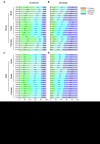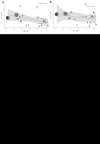Thyroid cancer trends in China and its comparative analysis with G20 countries: Projections for 2020-2040
- PMID: 38873786
- PMCID: PMC11177899
- DOI: 10.7189/jogh.14.04131
Thyroid cancer trends in China and its comparative analysis with G20 countries: Projections for 2020-2040
Abstract
Background: Thyroid cancer, a leading type of endocrine cancer, accounts for 3-4% of all cancer diagnoses. This study aims to analyse and compare thyroid cancer patterns in China and the Group twenty (G20) countries, and predict these trend for the upcoming two decades.
Methods: This observational longitudinal study utilised data from the Global Burden of Disease (GBD) study 2019. We used metrics including incidence, mortality, mortality-incidence ratio (MIR), age-standardised rate (ASR) and average annual percent change (AAPC) to examine thyroid cancer trends. Joinpoint regression analysis was used to identify periods manifesting notable changes. The association between sociodemographic index (SDI) and AAPC were investigated. The autoregressive integrated moving average (ARIMA) model was used to predict thyroid cancer trends from 2020 to 2040.
Results: From 1990 to 2019, thyroid cancer incidence cases in China increased by 289.6%, with a higher AAPC of age-standardised incidence rate (ASIR) in men. Contrastingly, the G20 demonstrated a smaller increase, particularly among women over 50. Despite the overall age-standardised mortality rate (ASMR) was higher in the G20, the increase in mortality was less pronounced than in China. Age-standardised incidence rate increased across all age groups and genders, with a notable rise among men aged 15-49. ASMR decreased in specific age groups and genders, especially among women. Conversely, the ASMR significantly increased in group aged over 70. The MIR exhibited a declining trend, but this decrease was less noticeable in men and the group aged over 70. Joinpoint analysis pinpointed significant shifts in overall ASIR and ASMR, with the most pronounced increase in ASIR during 2003-2011 in China and 2003-2010 in the G20. Predictions suggested a continual ASIR uptrend, especially in the 50-69 age group, coupled with a predicted ASMR downturn among the elderly by 2040. Moreover, the proportion of thyroid cancer deaths attributable to high body mass index (BMI) escalated, with significant increase in Saudi Arabia and a rise to 7.4% in China in 2019.
Conclusions: Thyroid cancer cases in incidence and mortality are escalating in both China and the G20. The increasing trend may be attributed to factors beyond overdiagnosis, including environmental and genetic factors. These findings emphasise the necessity for augmenting prevention, control, and treatment strategies. They also highlight the significance of international collaboration in addressing the global challenge posed by thyroid cancer.
Copyright © 2024 by the Journal of Global Health. All rights reserved.
Conflict of interest statement
Disclosure of interest: The authors completed the ICMJE Disclosure of Interest Form (available upon request from the corresponding author) and disclose no relevant interests.
Figures






Similar articles
-
Temporal trends of thyroid cancer in China and globally from 1990 to 2021: an analysis of the global burden of Disease Study 2021.Sci Rep. 2024 Oct 26;14(1):25538. doi: 10.1038/s41598-024-77663-5. Sci Rep. 2024. PMID: 39462100 Free PMC article.
-
Comparison of trend analysis of varicella zoster disease burden between China and the world 1990-2021 and disease burden forecast 2030.Front Public Health. 2025 Mar 10;13:1535977. doi: 10.3389/fpubh.2025.1535977. eCollection 2025. Front Public Health. 2025. PMID: 40129585 Free PMC article.
-
The trend of AIDS in China: A prediction and comparative analysis with G20 countries based on the Global Burden of Disease Study 2019.J Glob Health. 2024 Mar 1;14:04029. doi: 10.7189/jogh.14.04029. J Glob Health. 2024. PMID: 38426702 Free PMC article.
-
Global burden of myocarditis in youth and middle age (1990-2019): A systematic analysis of the disease burden and thirty-year forecast.Curr Probl Cardiol. 2024 Sep;49(9):102735. doi: 10.1016/j.cpcardiol.2024.102735. Epub 2024 Jun 29. Curr Probl Cardiol. 2024. PMID: 38950720 Review.
-
Unraveling the global burden of inflammatory bowel disease (1990-2019): A Joinpoint regression analysis of divergent trends in 10-24 and 50-69 age cohorts.Autoimmun Rev. 2024 Jun;23(6):103586. doi: 10.1016/j.autrev.2024.103586. Epub 2024 Jul 30. Autoimmun Rev. 2024. PMID: 39084279 Review.
Cited by
-
Effect of air pollution on the global burden of cardiovascular diseases and forecasting future trends of the related metrics: a systematic analysis from the Global Burden of Disease Study 2021.Front Med (Lausanne). 2024 Oct 11;11:1472996. doi: 10.3389/fmed.2024.1472996. eCollection 2024. Front Med (Lausanne). 2024. PMID: 39464269 Free PMC article.
-
Disparities, trends, and projections of cancer mortality burden related to high body mass index in China from 2005 to 2030.Cell Rep Med. 2025 Jun 17;6(6):102137. doi: 10.1016/j.xcrm.2025.102137. Epub 2025 May 15. Cell Rep Med. 2025. PMID: 40378844 Free PMC article.
-
Global burden of pneumoconiosis attributable to occupational particulate matter, gasses, and fumes from 1990~2021 and forecasting the future trends: a population-based study.Front Public Health. 2025 Jan 8;12:1494942. doi: 10.3389/fpubh.2024.1494942. eCollection 2024. Front Public Health. 2025. PMID: 39845664 Free PMC article.
-
Global, regional, and national burden of thyroid cancer in women of child-bearing age, 1990 to 2021 and predictions to 2035: An analysis of the global burden of disease study 2021.Front Endocrinol (Lausanne). 2025 Jun 27;16:1555841. doi: 10.3389/fendo.2025.1555841. eCollection 2025. Front Endocrinol (Lausanne). 2025. PMID: 40655400 Free PMC article.
-
The Global Burden of Migraine: A 30-Year Trend Review and Future Projections by Age, Sex, Country, and Region.Pain Ther. 2025 Feb;14(1):297-315. doi: 10.1007/s40122-024-00690-7. Epub 2024 Dec 11. Pain Ther. 2025. PMID: 39661241 Free PMC article.
References
Publication types
MeSH terms
LinkOut - more resources
Full Text Sources
Medical
